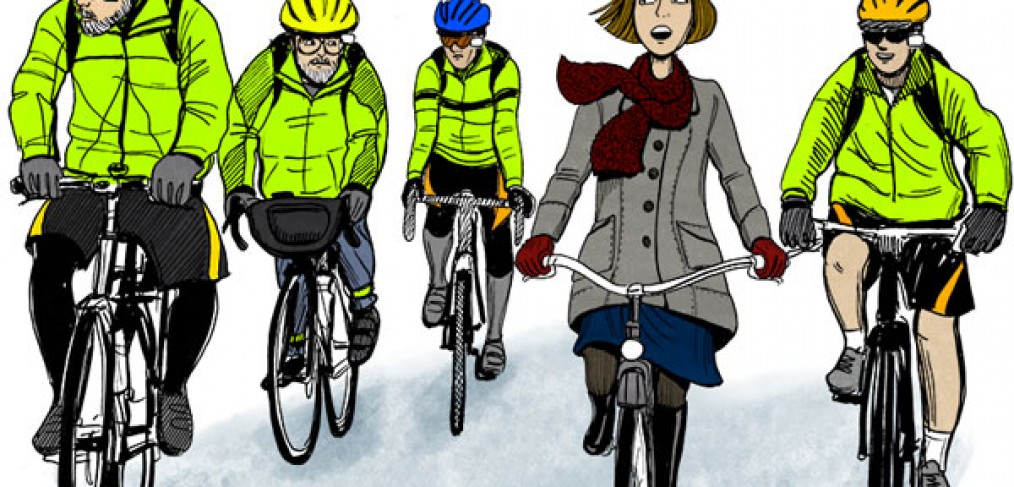
Uniform
The other day I was riding to work when I happened to notice the other people riding bicycles around me.
This was more of a coincidence than typical of what I see everyday. But I wondered- does not wearing a fluorescent uniform make a person stand out more?

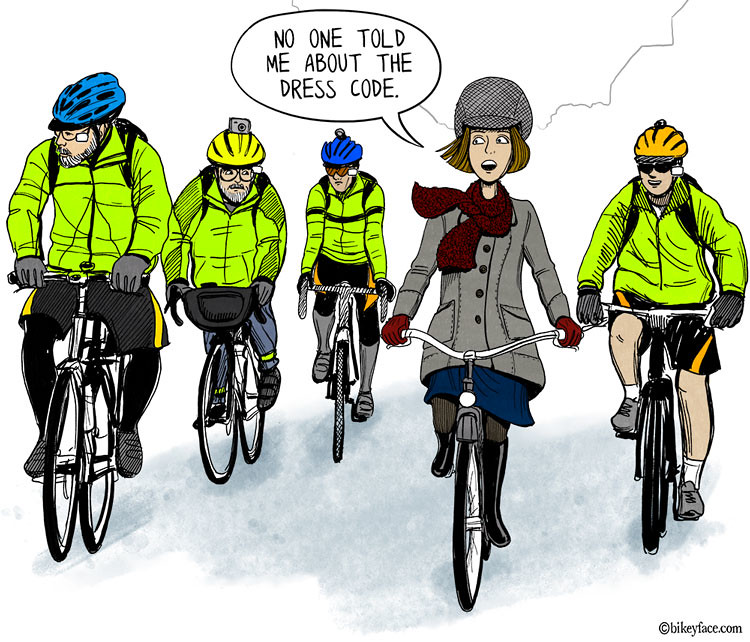
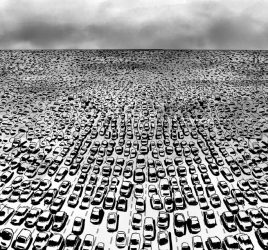
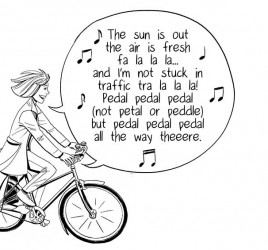
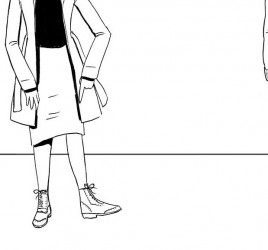
I think dressing to be visible is important when light is not optimal. I personally don’t like “hi-viz” colors, but I gravitate toward brighter colors. No camera for me, but I do wear a helmet and a mirror. If you are commuting, and conditions are nice, then you stand out just fine. Ride on!
Yes, I think so. At times I feel out of place but my fluorescent jacket from my road cycling days doesn’t coordinate well with my current wardrobe. Yet I have my own way of staying visible. I like to wear fuchsia, cobalt blue, coral and even fluorescent yellow (although not all at the same time)…when it’s a belt, slip for my skirt or in my statement necklace!!
Viva diversity. Wear what you want that day.
Same “dress code” road construction workers have. The road is a dangerous place and it’s good to be seen.
Study after study after study has shown that cycling with fluorescent colors makes NO DIFFERENCE WHATSOEVER. the lack of visibility seems to be a psychological issue with drivers, not a matter of visibility. Wear brights if you want to; it does have the advantage that drivers have no excuse when they hit you.
One thing that does make a definite difference is being female. Drivers consistently give women more room–which further suggests the problem is psychological; guys just don’t rate a notice. The positive side of sexism! 🙂
The claim that being (or appearing) female — the researcher was a male wearing a wig — increases passing clearance was made in a a study which has been thoroughly debunked, see http://www.bhsi.org/walkerstudy.htm. The average increase in clearance was 5.5 inches but the average clearance was over 4 feet. Also please name the studies which you claim show that high-visibility clothing does not increase safety.
I believe there was a study done in EnnZed about HiViz when they were considering making it mandatory that concluded it was of minimal help. I can’t find the link at the moment, but it’s about 2 years or so old. The study looked at cyclists killed and if they were wearing HiViz or not, and found the proportion of cyclists killed in HiViz was about the same as the proportion wearing it or slightly higher. When applying SMIDSY data where known HiViz fared worse than regular clothing.
I didn’t find that “debunking” to be nearly so compelling or thorough, and the criticism of a “small” shift in an average passing distance seems almost statistically illiterate when one considers what that means for the tails of a bell curve (which passing distances resemble). Apparently excluded from the helmeted sample (why, I do not know, but I have attempted to check this and that appears to be the case from what I read) were two actual collisions by overtaking vehicles, which would seem to make this point rather well. One problem with inferring (reduced) safety from this sort of study is that actual crashes are fortunately very rare and difficult to determine definitively without a huge sample.
The high-viz study was also done by Walker: “Walker, I., Garrard, I. and Jowitt, F. (2014) The influence of a bicycle commuter’s appearance on drivers’ overtaking proximities : an on-road test of bicyclist stereotypes, high- visibility clothing and safety aids in the United Kingdom. Accident Analysis and Prevention, 64. pp. 69-77. ISSN 0001-4575
Link to official URL (if available): http://dx.doi.org/10.1016/j.aap.2013.11.007”
He references another which (according to his paraphrase) also found no particular help from hi-viz clothing.
The thing I found most disturbing about his results was the passing distance experienced by “POLITE” hi-viz vests, which you would think would be seen as probably “POLICE” and hence would have similar passing distances, when in fact it was completely the opposite. I have my own unflattering guesses about what mental processes result in this outcome, but certainly this suggests that our intuition is not very good at predicting these outcomes.
http://eprints.nottingham.ac.uk/12855/
“No reduction in crash risk could be demonstrated…The study results do not demonstrate a protective effect as expected given previous work testing the effects of such aids on drivers’ awareness of cyclists and pedestrians. This study demonstrates the importance of understanding why many cyclists remain at risk of collision crash resulting in injury despite the use of conspicuity aids.
I might hesitate to cite bhsi.org: it is an organisation founded in order to promote a predetermined agenda rather than to seek truth. For example, sadly, they still cite the infamous Thompson, Rivera, Thompson study that produced the irreproducible and methodologically obscene 88% figure, as well as ignoring much solid research that does not support their message.
That suggests a prior for credibility of their “thorough debunking” of the Walker study. It doesn’t necessarily mean they’re wrong, and they make a couple of valid points. However, I don’t find their comments to be terribly compelling due to the number of claims that they make that rely not on correcting the methodology but rather on trying to make a mathemotional argument.
It matters in court. After a crash, when they’re assigning responsibility for negligence, someone with lighting and very visible clothing is less responsible for the crash than otherwise. Don’t shoot the messenger – that’s the way the court system works. Even if it’s clear the motorist was primarily responsible for the crash, they’ll divy up the negligence based on things like this.
That may be the way the court system works, but I see no reason to cheer the courts on for working that way or to encourage people to make that judgement. I have said it before in other forums, it is unbelievable and intolerable that cyclists (and pedestrians) are expected to obey imaginary safety laws, when motorists are given a pass on laws that are actually on the books. Before a court even mentions these extralegal tribal safety dress codes, they had better be sure that the motorist was obeying every single applicable law in their actions leading up to the crash. Speed, lane position, use of turn signals, use of headlights when wipers are on, texting, cracked windshield, everything.
BTW – which studies were those? I’d love to see how they were designed. If they actually exist, I’d bet they have methodology holes you could drive a truck through.
OTOH, there is a study finding that a pony tail gets you improved passing distances. Scientific American had a blog about it here: http://www.scientificamerican.com/article/strange-but-true-helmets-attract-cars-to-cyclists/
Best part of that article? “‘If you really want the greatest passing distance, you should wobble down the road,’ looking as inept as possible, he adds.” – Which ***totally*** works. Just do yourself a favor and make sure you do the wobble well before they get to you, and straighten out when they actually pass. On rare occasions, when I clearly have an ignorant git behind me, not tracking a straight line helps.
If everyday movement is really that dangerous, the infrastructure is broken. In countries like Denmark and Netherlands, where way more people bike and the rate of accidents is far lower, most people dress in whatever they were wearing at the time.
If I could share a photo of my bike I would. I decorate it seasonally. My husband just made a big dove that is sitting on my front bike rack. I think my decorated bike keeps me visible. When I am off my bike you would not know that I just came by bike.